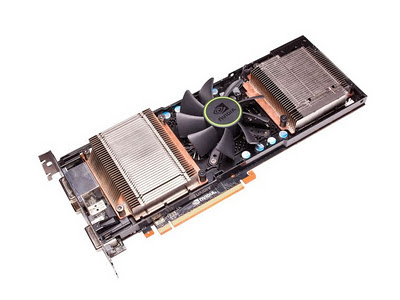Only a handful of people have the cash to invest in dual-GPU graphics cards, but manufacturers still place plenty of stock in their success thanks to the “halo effect” they have on the rest of their ranges. AMD’s recent Radeon HD 6990 is today followed into the Labs by the GeForce GTX 590, Nvidia’s wallet-busting rebuke.
 |
| Nvidia GeForce GTX 590 |
Just like the HD 6990, the GTX 590 comprises two modified GPUs – in this case the GTX 580 – soldered onto a real slab of a circuit board. Nvidia has tweaked clock speeds to fit: the 772MHz cores have been reined in to 607MHz, the 1,544MHz shader clock to 1,224MHz, and the combined 3GB of GDDR5 memory from 4,008MHz to 3,420MHz.
Nvidia has retained its familiar stream processor architecture, with 32 clusters across both cores, each containing 32 stream processors. It’s a proven system but, when stacked against the HD 6990, sounds relatively weak: AMD’s card contains 3,072 stream processors alongside 5.2 billion transistors, with the GTX 590 offering 1,024 processors and “just” 3 billion transistors.
The Nvidia card lagged slightly behind in our less demanding benchmarks. An average of 60fps in our 1,920 x 1,080 Very High quality Crysis test with 8x anti-aliasing is 3fps slower than the HD 6990, and this pattern was repeated in the equivalent Just Cause 2 test, where the Nvidia card scored 90fps to the AMD chip’s 96fps.
But when we really cranked up the settings to enthusiast levels – aided by a triple-monitor setup with a resolution of 5,760 x 1,080 – the GTX 590 showed its strength. It averaged a playable 32fps in our Very High Crysis benchmark at this extreme resolution; the HD 6990 managed 30fps. Adding 8x anti-aliasing widened the gap: the GTX 590’s 23fps average was a massive 10fps quicker than the struggling HD 6990.
Just Cause 2 saw similar results at this huge resolution: the GTX 590 was 6fps quicker than the HD 6990. Only in Stalker: Call of Pripyat did the AMD card maintain its lead at the highest resolutions; the HD 6990 was 5fps faster at its stock speed and 7fps quicker with its boosted BIOS enabled.
The GTX 590 evidently has more legs in the most crushingly demanding tests, then, and other attributes mean it’s easier to live with than the HD 6990. It’s around an inch shorter, which shouldn’t be sniffed at – it actually fit into our Cooler Master CM 690 II Advanced test rig without the need to remove hard disk cages and try different PCI-Express x16 slots. The GTX 590 also seemed barely louder than the single-chip GTX 580, whereas the HD 6990 was an incredibly noisy card under load.
There was less to choose between the two cards when it came to power consumption. The GTX 590’s peak power draw in our test rig was 466W; the HD 6990 drew a peak of 423W when using its stock BIOS, with this rising to 477W with its overclocked mode enabled. For either you’ll need two eight-pin power connectors.
Last but absolutely not least, there’s the issue of price. At £570 inc VAT, the GTX 590 is mere pounds more expensive than the HD 6990, so price really shouldn’t sway you either way. Instead, the buying decision comes down to other factors, and the GTX 590 has the edge. It held on for longer as we upped the quality and resolution settings in our tests, and its smaller size and more bearable noise make it easier to live with. There’s not a lot in it, but this generation's bragging rights go to Nvidia.

Conversion Conversion Emoticon Emoticon